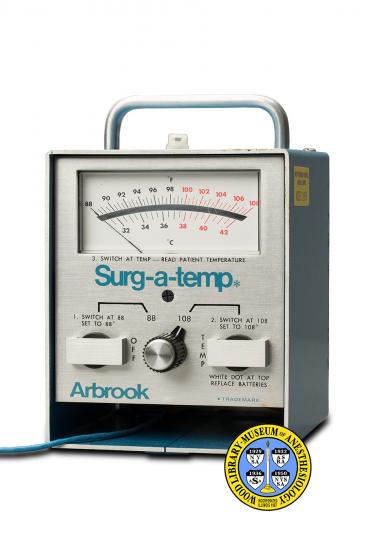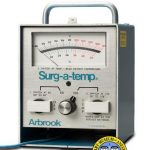Arbrook Surg-a-temp
Many factors can cause changes in the patient’s body temperature during surgery, which can lead to some medical complications. Anesthesiologists monitor the patient to prevent both hyperthermia (when the core temperature is too high) and hypothermia (when it is too low.) There are several locations at which a patient’s core temperature can be reflected with varying degrees of accuracy, including the mouth, nose, axilla (armpit), rectum, and the tympanic membrane (eardrum.) Tympanic thermometers were introduced in the 1950s.
Arbrook, Inc. made the Surg-a-temp temperature monitoring system in the 1970s. This apparatus used a heat-sensing thermocouple to detect temperature at the tympanic membrane, and relayed this information through a wire to the meter, where it was displayed on the gauge by an indicator needle. Today’s tympanic thermometers are hand-held devices, with an infrared probe to detect the patient’s temperature and a digital display screen.
Catalog Record: Arbrook Surg-a-temp
Access Key: aldz
Accession No.: 1990-12-11-1 F
Publisher: Arlington, Texas : Arbrook, Inc., [between 1971 and 1988?].
Physical Descript: 1 thermometer + 1 probe : metals, plastics, paint ; 17.5 x 12.2 x 14.4 cm.
Subject: Temperature Measurement.
Subject: Thermometers.
Subject: Monitoring, Intraoperative – instrumentation.
Note Type: General
Notes: The early year in the date range for the possible year of manufacture (1971)
is based a marking on the back of the device: “©Arbrook, Inc., Arlington,
Texas ‘71”. Of note, the year that the company applied to trademark the
name, “SURG-A-TEMP” was 1973. The end date for the possible year of
manufacture of this Surg-a-temp is based on the condition, the year that
Arbrook, Inc. let the trademark expire (1989), and the year it was donated to
the WLM (1990).The date range could change if documentation indicates the
range should be corrected.
Note Type: Citation
Notes: Parikh BR, Rosenberg H. Temperature monitoring. Ehrenwerth J, Eisenkraft JB,
Berry JM. Anesthesia Equipment: Principles and Applications. Philadelphia,
PA: Elsevier/Saunders; 2013: 295-306.
Note Type: Citation
Notes: Hooper VD. Care of the patient with thermal imbalance. In: Odom-Forren J, ed.
Drain’s Perianesthesia Nursing. 6th ed. St. Louis: Elsevier; 2013:740-742.
Note Type: Citation
Notes: Surg-a-temp temperature monitoring system [marketing booklet]. Arlington,
Texas: Arbrook, Inc.; 1972.
Note Type: Citation
Notes: Surg-a-temp temperature monitoring system: operating instructions. Arlington,
Texas: Arbrook, Inc.; 1971.
Note Type: Citation
Notes: Webb GE. Tympanic thermography [meeting exhibit description and marketing
literature]. Arlington, Texas: Arbrook, Inc.; [1971-1977?].
Note Type: Physical Description
Notes: One electronic thermometer with probe connection for tympanic temperature
measurements; The sides and top of the thermometer are made from one
continuous sheet of metal that is painted blue; The face is stainless steel
with a gauge in the upper portion and controls in the lower portion; The
gauge is in a rectangular window, and composed of a curved line, with
increments for Celsius below the line and increments for Fahrenheit above;
For Celsius the increments indicate ever .5 degrees and are numbered from 32
to 42 at the even whole numbers; For Fahrenheit the increments also indicate
every .5 degrees and are numbered from 88 to 108 at the even whole numbers;
All of the increments and numbers at or above 38 degrees Celsius and 100
degrees Fahrenheit are the color red; Below the window is a manufacturer
marking that is part of three instructions printed on the front, “3. SWITCH
AT TEMP —READ PATIENT TEMPERATURE”; Below this is the name of the device in
large blue lettering, “Surg-a-temp*”; Below this are three dials; The dial on
the left is protected from accidental movement by a bar; Markings above the
dial include, “1. SWITCH AT 88 [new line] SET TO 88°; To the right of this
dial is the marking, “OFF”; The dial in the center may be turned to a
position on the left that points to the number “88”, or to the right,
pointing to the number, “108”; The dial on the right is also protected from
accidental movement by a bar; Printed on the left of this dial is the word,
“TEMP”; Above this dial is marked, “2. SWITCH AT 108 [new line] SET TO 108°”;
Marked below the dial on the right is, “WHITE DOT AT TOP REPLACE BATTERIES”;
Below this is marked, in blue, “* TRADEMARK”; In blue lettering, marked on
the lower left corner of the front of the device is the company’s name,
“Arbrook”; Below the face, in the front of the device, is a shelf like
opening for storing the cord connection for the probe; The connection is
insulated in a blue plastic coating and is approximately 323 cm in length; On
the top of the device is a handle and a Dymo tape label marked, “ANES. NO.
1”; On the right side of the device is a yellow sticker marked, “WEST
SUBURBAN HOSPITAL MEDICAL CENTER ASSET 02599”; The back is stainless steel
and is marked in dark blue print; The markings include, “Surg-a-temp* [new
line] temperature monitoring instrument; To calibrate the instrument for
temperature measurement: [new line] 1. Position Selector Switch to 88, meter
should indicate 88°. [new line] 2. If 88° is not indicated on meter, rotate
left hand calibration wheel as required to properly align indicator pointer.
[new line] 3. Position Selector Switch to 108, meter should indicate 108°.
[new line] 4. If 108° is not indicated on meter, rotate right hand
calibration wheel as required to properly align indicator pointer. [new line]
5. When indicator pointer has been adjusted to the proper calibration reading
the Surg-a-Temp instrument is ready for sterile sensor connection. [new
line] BATTERY REPLACEMENT INDICATOR” [new line] When white dot on right hand
calibration wheel appears centered at top of wheel, battery expiration is
indicated. (Refer to Battery Replacement in Surg-a-Temp Instruction Booklet.)
[new line] *Trademark ©Arbrook, Inc., Arlington, Texas ‘71”.
Note Type: Reproduction
Notes: Photographed by Mr. Steve Donisch, February 10, 2014.
Note Type: Historical
Notes: The Surg-a-temp, introduced by Arbrook, Inc. around 1971, was an early
commercial tympanic thermometer made for monitoring body temperature during
anesthesia and surgery.
The tympanic membrane is the medical name for the eardrum, located at the end
of each ear canal. The blood that supplies the eardrum is close to core body
temperature. Core body temperature is the temperature deep in the chest and
abdomen where major body organs, such as the heart and liver, are located.
Critical functions in the body depend on the maintenance of a normal core
temperature. A number of factors can alter normal body temperature during
anesthesia and surgery. Because of this, and the fact that the ear canal is
easily accessible, there was strong interest in the development of technology
to accurately measure the temperature of the eardrum.
The Surg-a-temp was a thermocouple thermometer. It was used by inserting a
thin, disposable probe into the patient’s ear canal until the sensor at the
end of the probe came into contact with the eardrum. Accurately positioning
the probe turned out to be easier said than done. In addition to the risk of
perforating the eardrum, the resistance from the curve of the ear canal could
easily be mistaken for having reached the eardrum. Also, wax could easily
obstruct contact with the eardrum. The difficulty in correctly inserting the
tympanic probe, despite the development of softer and more pliable probes, is
one reason why this method of temperature monitoring is no longer common. In
1989, Arbrook let the Surg-a-temp trademark expire.
Infrared, tympanic thermometers that enter the ear canal only a few
millimeters were introduced in 1984. They were very popular until researchers
demonstrated persistent inaccuracies. Rather than a single method for
measuring body temperature, anesthesiologists consider a number of variables,
including the patient’s needs and the surgical procedure, to choose the best
monitoring option among a number of alternatives.
Note Type: Publication
Notes: Dorman HP, inventor; Arbrook, Inc., assignee. Thermometer sheath. US patent 4
164,285. August 14, 1979.
Note Type: Publication
Notes: Ball C, Westhorpe RN. Temperature monitoring. Anaesth Intensive Care.
2010;38(3):413.
Note Type: Publication
Notes: Ring EFJ. The historical development of thermometry and thermal images in
medicine. J Med Eng Tech. 2006;30(4):192-198.
Note Type: Publication
Notes: Schmidt GH, inventor; Arbrook, Inc., assignee. Charging unit for portable
electronic thermometer. US design patent 245,976. October 4, 1977.
https://www.google.com/patents/USD245976. Accessed September 26, 2014.


